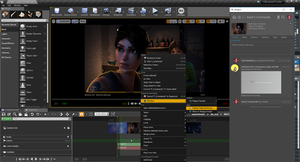 Right now, production for films, TV, video games, and Web sales are all done differently.
Right now, production for films, TV, video games, and Web sales are all done differently.
Five years from now, they will all be done in the same way, using “virtual stages” and virtual reality software.
As with everything else in tech, it’s starting at the top of the cost curve but will head down rapidly. Tools like the Unreal Engine cover the software side. Virtual stages represent the hardware side.
The cost of this gear is very high. But the gear is just the tip of the cost iceberg. You need people who can run it, you need people who can write code around it. You need people to integrate it, people who can tell stories using it, and you need big bandwidth to distribute it.
The Mandalorian was produced using this technology. It’s more than a green screen. It’s a surround that actors interact with, in real time.
But the result doesn’t have to be a flat image you watch on a screen. It can be what seems to be an objective reality, perhaps experienced using 3D glasses. That’s how it’s delivered now in video games. But if the software techniques used for the game and the screen are the same, and with Epic’s Unreal Engine they are, you can now put your viewer (or gamer) inside the frame.
Even this is just the tip of the iceberg. Today there are just a few of these virtual stages being used for high-end movie production. There’s a mad scramble in every city with studios to acquire this kit and put it to use. There’s also a huge market for anyone who can gain the production and programming skills to use it. Which means there are high costs for virtual staging. You only use it for things that can’t be recreated on a real set, and then you do it sparingly. It’s a “special effect.”
This is going to change, quickly. As the chip shortage eases the hardware shortage will disappear, and prices will come down. As more people see the opportunity, more people will gain the skills and those costs will come down. Within a few years you’ll see virtual staging used to produce things that are now done on live sets, or on location. Remember, with virtual staging and 3D software the game and the movie are practically produced together. The increased revenue coming from that will be the spur toward bringing the virtual sets into what looks like reality.
 At this point we won’t just be talking about movies or video games. You will be able to show houses on a virtual stage to remote buyers. You’ll be able to even sell furniture. Customers input their room dimensions, then a stylist takes them to the virtual showroom to mix-and-match furniture and everything else. This all starts at the high end of the market, then gradually comes down. It starts inside 3D glasses, then moves to live showrooms. Here’s your new living room. Feel the quality, move things around. Here’s the bill, it will be installed in a week. It’s the miracle of set dressing.
At this point we won’t just be talking about movies or video games. You will be able to show houses on a virtual stage to remote buyers. You’ll be able to even sell furniture. Customers input their room dimensions, then a stylist takes them to the virtual showroom to mix-and-match furniture and everything else. This all starts at the high end of the market, then gradually comes down. It starts inside 3D glasses, then moves to live showrooms. Here’s your new living room. Feel the quality, move things around. Here’s the bill, it will be installed in a week. It’s the miracle of set dressing.
Along the way dozens of industries are going to be disrupted. Not just video production and gaming, but marketing, the ways in which we buy and sell big-ticket items, are going to be transformed. Hundreds of new companies are going to be created, employing hundreds of thousands of people. But millions of others, anyone devoted to how things are done now, is going to see their careers at risk.
It’s all right around the corner.









